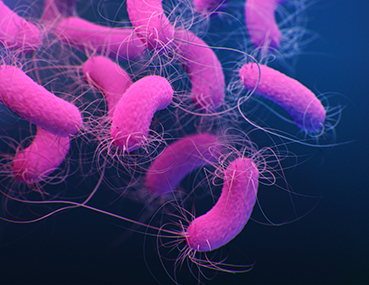Bacterial biofilms persistent on dry environmental surfaces in healthcare facilities play an important role in the occurrence of healthcare-associated infections (HAI). Compared to wet surface biofilms and planktonic bacteria, dry surface biofilms (DSB) are more tolerant to disinfection. However, there is no official method for developing DSB for in vitro disinfectant efficacy testing. The objectives of this study by Nkemngong, et al. (2020) were to (i) develop an in vitro model of DSB of S. aureus and P. aeruginosa for disinfectant efficacy testing and (ii) investigate the effect of drying times and temperatures on DSB development. The researchers hypothesized that a minimum six log10 density of DSB could be achieved on glass coupons by desiccating wet surface biofilms near room temperatures. They also hypothesized that a DSB produced by the model in this study will be encased in extracellular polymeric substances (EPS).
S. aureus ATCC-6538 and P. aeruginosa ATCC-15442 wet surface biofilms were grown on glass coupons following EPA MLB SOP MB-19. A DSB model was developed by drying coupons in an incubator and viable bacteria were recovered following a modified version of EPA MLB SOP MB-20. Scanning electron microscopy was used to confirm the EPS presence on DSB.
Overall, a minimum of six mean log10 densities of DSB for disinfectant efficacy were recovered per coupon after drying at different temperatures and drying times. Regardless of strain, temperature and dry time, 86% of coupons with DSB were confirmed to have EPS.
The researchers conclude that a rapid model for developing DSB with characteristic EPS was developed for disinfectant efficacy testing against DSB.
Reference: Nkemngong CA, et al. A rapid model for developing dry surface biofilms of Staphylococcus aureus and Pseudomonas aeruginosa for in vitro disinfectant efficacy testing. Antimicrobial Resistance & Infection Control. Vol. 9, No. 134. 2020.

What’s up to all, because I am actually keen of reading this weblog’s post to be updated daily. It contains nice information.
I blog quite often and I genuinely appreciate your content. This great article has really peaked my interest. I will book mark your website and keep checking for new information about once a week. I subscribed to your RSS feed as well.
This post is priceless. How can I find out more?
It’s a shame you don’t have a donate button! I’d certainly donate to this brilliant blog! I suppose for now i’ll settle for book-marking and adding your RSS feed to my Google account. I look forward to brand new updates and will talk about this site with my Facebook group. Chat soon!